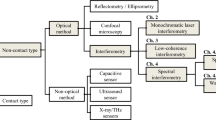Abstract
The technique of relative optical interference intensity (ROII) has been developed for measuring lubricant film thickness. Here, we describe in detail the principle and the characteristics of the film thickness measurement system based on the existing ROII method. Some researchers have reported a large calculation error in film thickness with the use of ROII method. The description and analysis of the resolution, accuracy and important factors influencing the measurement results of this measurement technique presented here illustrate that the ROII method should be used in a specific optical system with negligible multiple beam reflections, but not in an ordinary one. The reported calculation error in film thickness using the ROII method comes from using an inappropriate optical system and inappropriate coating parameters. In fact, the ROII method, which is a very accurate method for measuring the thickness of a thin lubricant film, with a high resolution in film thickness of 0.5 nm and a horizontal resolution of 1.4 μm, can only be used in a two-beam interference system.









Similar content being viewed by others
Abbreviations
- e :
-
The extinction coefficient
- h :
-
Lubricant film thickness
- Δh :
-
Variation of the lubricant film thickness
- I :
-
Light intensity
- I 1 :
-
Light intensity of beam 1
- I 2 :
-
Light intensity of beam 2
- I 3 :
-
Light intensity of the secondary reflection component
- I max :
-
Maximum interference light intensity
- I min :
-
Minimum interference light intensity
- I max(n) :
-
Maximum interference light intensity of the interference order n
- I min(n) :
-
Minimum interference light intensity of the interference order n
- ΔI :
-
The grey value gradation
- \( \overline{I} \) :
-
Relative interference light intensity
- λ :
-
Wave length of the incident light
- k :
-
Reflective index of lubricant
- δ:
-
Phase difference of two beam interference
- Φ:
-
Phase change caused by the surfaces of the chromium layer and the steel ball
- \( \overline{I}_{0} \) :
-
Relative light intensity when the lubricant film thickness is zero
- n :
-
Interference order
References
Cameron, A., Gohar, R.: Theoretical and experimental studies of the oil film in lubricated point contact. Proc. R. Soc. A 291, 520 (1966)
Foord, C.A., Hammann, W.C., Cameron, A.: Evaluation of lubricants using optical elastohydrodynamics. ASLE Trans. 11, 31–43 (1968)
Wedeven, L.D., Foord, C.A., Westlake, F.J., Cameron, A.: Optical elastohydrodynamics. Proc. Inst. Mech. Eng. 184(1), 487–505 (1969–1970)
Westlake, F., Cameron, A.: A study of ultra-thin lubricant films using an optical technique. In: Proceedings of the Symposium on Experimental Methods in Tribology, March 1968; also Proc. Inst. Mech. Eng., vol. 182, pp. 75–78 (1967–1968)
Westlake, F.J.: An interferometric study of ultra-thin fluid films. PhD thesis. University of London, London (1970)
Spikes, H.A., Guangteng, G.: Properties of ultra-thin lubricating film using wedged spacer layer optical interferometry. In: Dowson, D. (ed.) Proceedings of the 14th Leeds-Lyon Symposium on Tribology, pp. 275–279 (1988)
Johnston, G.J., Wayte, R., Spikes, H.A.: The measurement and study of very thin lubricant films in concentrated contact. STLE Tribol. Trans. 34(2), 187–194 (1991)
Cann, P.M., Spikes, H.A., Hutchinson, J.: The development of a spacer layer imaging method (SLIM) for map** elastohydrodynamic contacts. STLE Tribol. Trans. 39, 915–921 (1996)
Spikes, H.A., Cann, P.M.: The development and application of the spacer layer imaging method for measuring lubricant film thickness. Proc. Inst. Mech. Eng. J: J. Eng. Tribol. 215(J3), 261–277 (2001)
Glovnea, R.P., Forrest, A.K., Olver, A.V., Spikes, H.A.: Measurement of sub-nanometer lubricant films using ultra-thin film interferometry. Tribol. Lett. 15, 217–230 (2003)
Roberts, A.D., Tabor, D.: The extrusion of liquids between highly elastic solids. Proc. R. Soc. Lond. A 325, 323–345 (1971)
Luo, J.B.: Study on the experimental technique and properties of thin film lubrication. PhD thesis. Tsinghua University, Bei**g (1994)
Luo, J.B., Wen, S.Z., Huang, P.: Thin film lubrication, part I: the transition between EHL and thin film lubrication. Wear 194, 107–115 (1996)
Luo, J.B., Wen, S.Z.: Mechanism and characteristics of thin film lubrication at nanometer scale. Sci. China Ser. A 39(12), 1312–1322 (1996)
Luo, J.B., Huang, P., Wen, S.Z., Lawrence, L.: Characteristics of liquid lubricant films at the nano-scale. ASME Trans. J. Tribol. 121(4), 872–878 (1999)
Luo, J.B., Shen, M.W., Wen, S.Z.: Tribological properties of nanoliquid film under an external electric field. J. Appl. Phys. 96(11), 6733–6738 (2004)
Guo, F., Wong, P.L.: A multi-beam intensity-based approach for lubricant film measurements in non-conformal contacts. Proc. Inst. Mech. Eng. J.: J. Eng. Tribol. 216, 281–291 (2002)
Guo, F., Wong, P.L.: A wide range measuring system for thin lubricating film: from nano to micro thickness. Tribol. Lett. 17, 521–531 (2004)
Yan, Y.B.: Applied Physical Optics. China Machine Press, Bei**g (1990)
Born, M., Wolf, E.: Principles of Optics, 5th edn, pp. 257–270. Pergamon Press, New York (1975)
Zhuang, S.L., Qian, Z.B.: Optical Transfer Function. China Machine Press, Bei**g (1981)
Wong, P.L., Guo, F.: Effects of absorbing media on relative optical interference intensity ROII technique. Sci. China Ser. A 44, 431 (2001)
Bonn, M., Wolf, E.: Optical Principle. Science Press, Bei**g (1978)
Luo, J.B.: On Experimental Technique and Characteristic of Thin Film Lubrication, pp. 21–23. Tsinghua University, Bei**g (1994)
Acknowledgements
This work was supported by the National Natural Science Fund China, the 973 project, and the International Science & Technology Cooperation Project (No. 2008DFA51190). The authors would also like to express their thanks to Amatsuji Steel Ball Mfg. Co. Ltd, Japan for providing the highly polished steel ball.
Author information
Authors and Affiliations
Corresponding author
Rights and permissions
About this article
Cite this article
Ma, L., Zhang, C. Discussion on the Technique of Relative Optical Interference Intensity for the Measurement of Lubricant Film Thickness. Tribol Lett 36, 239–245 (2009). https://doi.org/10.1007/s11249-009-9479-6
Received:
Accepted:
Published:
Issue Date:
DOI: https://doi.org/10.1007/s11249-009-9479-6




